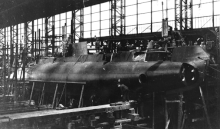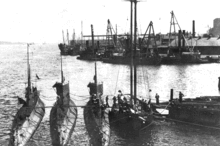

This article needs additional citations for verification. Please help improve this articlebyadding citations to reliable sources. Unsourced material may be challenged and removed.
Find sources: "British H-class submarine" – news · newspapers · books · scholar · JSTOR (April 2008) (Learn how and when to remove this message) |

| |
| Class overview | |
|---|---|
| Operators | |
| Preceded by |
|
| Succeeded by |
|
| In commission | 1915–1945 |
| Completed | 42 |
| Lost | 9 |
| Retired | 33 |
| General characteristics | |
| Type | Submarine |
| Displacement | |
| Length |
|
| Beam | 15 ft 4 in (4.67 m) |
| Installed power |
|
| Propulsion | 2 × propeller shafts |
| Speed | |
| Range |
|
| Complement | 22 |
| Armament |
|



The British H-class submarines were Holland 602 type submarines used by the Royal Navy. The submarines constructed for the British Royal Navy between 1915 and 1919 were designed and built in response to German boats which mined British waters and sank coastal shipping with ease owing to their small size. The H class was created to perform similar operations in German waters, and to attack German submarines operating in British waters.
Despite their cramped size and lack of a deck gun on some submarines, the class was popular amongst submariners, and saw action all around the British Isles, some being transferred as far as the Adriatic. Owing to the late arrival of most of the class, they were unable to have much impact in service, only destroying two German submarines U-51 and UB-52 for the loss of four of their own number.
Post-war, many were retained in the Royal Navy for training purposes, while four more were lost in accidents during the 1920s. At the outbreak of the Second World War, the class was obsolete, but retained in training and coastal warfare roles to help the Royal Navy cope with heavy losses to the submarine fleet during the early stages of the war. Two were sunk in this role by German countermeasures. The Canada-built boats were equipped with Fessenden transducers, which were missing from the US-built boats.
Group 1 was built in Canada at the Canadian Vickers Yards in Montreal before being transported across the Atlantic and deployed from Britain as British shipyards were too busy to construct submarines at this time:
The second group was constructed simultaneously with the first group, but at Fore River YardatQuincy, Massachusetts in the then-neutral United States. When the U.S. government discovered the construction, they impounded all the completed units, releasing them only following their own declaration of war two years later. To escape this difficulty, the British government gave six units to the Chilean Navy as partial payment for the appropriation of six Chilean ships for British service in 1914:
Group 3 was the largest group, and was constructed in 1917–1919 in Britain, shipyard space having been granted to the project and more boats needed following the seizure of those building in the United States. They were built by Vickers, Cammell Laird, Armstrong Whitworth and William Beardmore at several locations, and most of the boats enjoyed long careers in the Royal Navy:
|
British naval ship classes of the First World War
| |
|---|---|
| Aircraft/Seaplane carriers |
|
| Dreadnought battleships |
|
| Pre-dreadnought battleships |
|
| Battlecruisers |
|
| Armoured cruisers |
|
| Heavy cruisers |
|
| Light cruisers |
|
| Protected cruisers |
|
| Scout cruisers |
|
| Destroyer flotilla leaders |
|
| Destroyers |
|
| Torpedo boats |
|
| Monitors |
|
| Minesweepers |
|
| Gunboats |
|
| Submarines |
|
| Sloops |
|
| naval trawlers |
|
| |
|
British naval ship classes of the Second World War
| |
|---|---|
| Aircraft carriers |
|
| Light aircraft carriers |
|
| Escort carriers |
|
| Battleships |
|
| Battlecruisers |
|
| Heavy cruisers |
|
| Light cruisers |
|
| Destroyer leaders |
|
| Destroyers |
|
| Frigates |
|
| Corvettes |
|
| Sloops |
|
| Minelayers |
|
| Minesweepers |
|
| Netlayers |
|
| Submarines |
|
| Coastal |
|
| Other |
|
| |
|
Submarines of the Chilean Navy
| ||||||||||||||||||
|---|---|---|---|---|---|---|---|---|---|---|---|---|---|---|---|---|---|---|
| Submarines |
| |||||||||||||||||